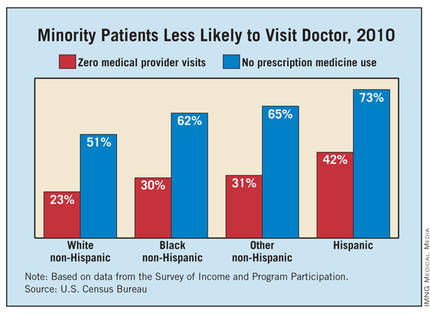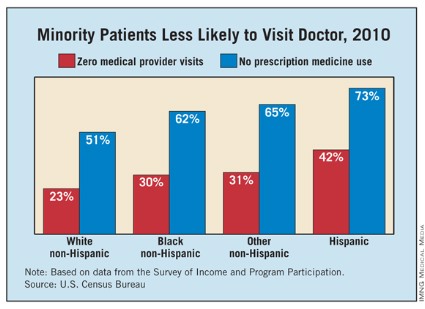User login
People aged 18-64 years are visiting the doctor less frequently than they did a decade ago: Average annual medical provider visits dropped about 19%, from 4.8 per year in 2001 to 3.9 per year in 2010, according to a report from the U.S. Census Bureau.
While the government did not delve into why, factors such as increasing insurance and copayment costs, declining middle-class income, and growing numbers of uninsured likely are behind the numbers, according to Dr. James Fasules, senior vice president for advocacy for the American College of Cardiology.
"For the middle class, disposable income has dropped," Dr. Fasules said in an interview. "People might make the decision that it would be better to have food on the table than to do a [preventive or elective] procedure."
But putting off necessary care ultimately costs the system more, Dr. Fasules pointed out. "If someone is not addressing their hypertension, is not taking care of their diabetes, by the time they present [for care], they’re much sicker and it costs more."
The report, "Health Status, Health Insurance, and Medical Services Utilization: 2010," looked at the number of visits to medical providers and dentists, the number of nights spent in the hospital, and the number of people who used prescription drugs per year. The report found that the average number of medical provider visits decreased among all groups, including those in poor health and those with insurance, between 2001 and 2010.
Among those people reporting at least one medical provider visit per year, the average number of medical provider visits fell from 6.4 per year in 2001 to 5.4 in 2010, the report said. For people who said they were in fair or poor health, the average number of visits fell from 12.9 per year to 11.6 per year.

Less than a quarter (24%) of uninsured individuals reported at least one yearly medical visit in 2010, compared with 28% in 2001, the Census found. Additionally, the percentage of uninsured individuals who received routine checkups decreased from 14% in 2001 to 12% in 2010.
"Here’s glaring data that a lot of people don’t have access to care," said Dr. Glen Stream, president of the American Academy of Family Physicians.
Dr. Stream also cited several potential factors in the decrease in visits: the rise in insurance premiums and out-of-pocket costs, the poor economy, the shortage of physicians, and the difficulty in getting timely appointments.
The decline in medical visits hasn’t affected individual family doctors, Dr. Stream said in an interview, since most already are working as much as they can. "When you don’t have an adequate supply of family physicians, they’re all working at or above capacity. It’s not typical that practices are seeing an inadequate number of patients coming to the door."
The census report also looked at health status. It found that close to one-third of all people aged 18-64 years reported excellent health in 2010, while another 57% reported "very good" or "good" health. Almost 8% said their health was just "fair," and a little more than 2% called their health "poor." More men than women called their health "excellent," and non-Hispanic blacks were both least likely to report excellent health and most likely to report fair or poor health.
Health status and medical services utilization were linked in the report, with people who reported excellent health less likely to use services than people in poor health. Among those reporting excellent health in 2010, 68% visited a medical provider at least once in the previous 12 months, 4% reported one or more overnight stays in a hospital, and 30% said they took prescription medication in the previous 12 months.
Meanwhile, among those who reported poor health in 2010, 94.3% said they visited a medical provider at least once, 40.5% said they had at least one overnight stay in a hospital, and 91.5% took at least one prescription medication, the report found.
People aged 18-64 years are visiting the doctor less frequently than they did a decade ago: Average annual medical provider visits dropped about 19%, from 4.8 per year in 2001 to 3.9 per year in 2010, according to a report from the U.S. Census Bureau.
While the government did not delve into why, factors such as increasing insurance and copayment costs, declining middle-class income, and growing numbers of uninsured likely are behind the numbers, according to Dr. James Fasules, senior vice president for advocacy for the American College of Cardiology.
"For the middle class, disposable income has dropped," Dr. Fasules said in an interview. "People might make the decision that it would be better to have food on the table than to do a [preventive or elective] procedure."
But putting off necessary care ultimately costs the system more, Dr. Fasules pointed out. "If someone is not addressing their hypertension, is not taking care of their diabetes, by the time they present [for care], they’re much sicker and it costs more."
The report, "Health Status, Health Insurance, and Medical Services Utilization: 2010," looked at the number of visits to medical providers and dentists, the number of nights spent in the hospital, and the number of people who used prescription drugs per year. The report found that the average number of medical provider visits decreased among all groups, including those in poor health and those with insurance, between 2001 and 2010.
Among those people reporting at least one medical provider visit per year, the average number of medical provider visits fell from 6.4 per year in 2001 to 5.4 in 2010, the report said. For people who said they were in fair or poor health, the average number of visits fell from 12.9 per year to 11.6 per year.

Less than a quarter (24%) of uninsured individuals reported at least one yearly medical visit in 2010, compared with 28% in 2001, the Census found. Additionally, the percentage of uninsured individuals who received routine checkups decreased from 14% in 2001 to 12% in 2010.
"Here’s glaring data that a lot of people don’t have access to care," said Dr. Glen Stream, president of the American Academy of Family Physicians.
Dr. Stream also cited several potential factors in the decrease in visits: the rise in insurance premiums and out-of-pocket costs, the poor economy, the shortage of physicians, and the difficulty in getting timely appointments.
The decline in medical visits hasn’t affected individual family doctors, Dr. Stream said in an interview, since most already are working as much as they can. "When you don’t have an adequate supply of family physicians, they’re all working at or above capacity. It’s not typical that practices are seeing an inadequate number of patients coming to the door."
The census report also looked at health status. It found that close to one-third of all people aged 18-64 years reported excellent health in 2010, while another 57% reported "very good" or "good" health. Almost 8% said their health was just "fair," and a little more than 2% called their health "poor." More men than women called their health "excellent," and non-Hispanic blacks were both least likely to report excellent health and most likely to report fair or poor health.
Health status and medical services utilization were linked in the report, with people who reported excellent health less likely to use services than people in poor health. Among those reporting excellent health in 2010, 68% visited a medical provider at least once in the previous 12 months, 4% reported one or more overnight stays in a hospital, and 30% said they took prescription medication in the previous 12 months.
Meanwhile, among those who reported poor health in 2010, 94.3% said they visited a medical provider at least once, 40.5% said they had at least one overnight stay in a hospital, and 91.5% took at least one prescription medication, the report found.
People aged 18-64 years are visiting the doctor less frequently than they did a decade ago: Average annual medical provider visits dropped about 19%, from 4.8 per year in 2001 to 3.9 per year in 2010, according to a report from the U.S. Census Bureau.
While the government did not delve into why, factors such as increasing insurance and copayment costs, declining middle-class income, and growing numbers of uninsured likely are behind the numbers, according to Dr. James Fasules, senior vice president for advocacy for the American College of Cardiology.
"For the middle class, disposable income has dropped," Dr. Fasules said in an interview. "People might make the decision that it would be better to have food on the table than to do a [preventive or elective] procedure."
But putting off necessary care ultimately costs the system more, Dr. Fasules pointed out. "If someone is not addressing their hypertension, is not taking care of their diabetes, by the time they present [for care], they’re much sicker and it costs more."
The report, "Health Status, Health Insurance, and Medical Services Utilization: 2010," looked at the number of visits to medical providers and dentists, the number of nights spent in the hospital, and the number of people who used prescription drugs per year. The report found that the average number of medical provider visits decreased among all groups, including those in poor health and those with insurance, between 2001 and 2010.
Among those people reporting at least one medical provider visit per year, the average number of medical provider visits fell from 6.4 per year in 2001 to 5.4 in 2010, the report said. For people who said they were in fair or poor health, the average number of visits fell from 12.9 per year to 11.6 per year.

Less than a quarter (24%) of uninsured individuals reported at least one yearly medical visit in 2010, compared with 28% in 2001, the Census found. Additionally, the percentage of uninsured individuals who received routine checkups decreased from 14% in 2001 to 12% in 2010.
"Here’s glaring data that a lot of people don’t have access to care," said Dr. Glen Stream, president of the American Academy of Family Physicians.
Dr. Stream also cited several potential factors in the decrease in visits: the rise in insurance premiums and out-of-pocket costs, the poor economy, the shortage of physicians, and the difficulty in getting timely appointments.
The decline in medical visits hasn’t affected individual family doctors, Dr. Stream said in an interview, since most already are working as much as they can. "When you don’t have an adequate supply of family physicians, they’re all working at or above capacity. It’s not typical that practices are seeing an inadequate number of patients coming to the door."
The census report also looked at health status. It found that close to one-third of all people aged 18-64 years reported excellent health in 2010, while another 57% reported "very good" or "good" health. Almost 8% said their health was just "fair," and a little more than 2% called their health "poor." More men than women called their health "excellent," and non-Hispanic blacks were both least likely to report excellent health and most likely to report fair or poor health.
Health status and medical services utilization were linked in the report, with people who reported excellent health less likely to use services than people in poor health. Among those reporting excellent health in 2010, 68% visited a medical provider at least once in the previous 12 months, 4% reported one or more overnight stays in a hospital, and 30% said they took prescription medication in the previous 12 months.
Meanwhile, among those who reported poor health in 2010, 94.3% said they visited a medical provider at least once, 40.5% said they had at least one overnight stay in a hospital, and 91.5% took at least one prescription medication, the report found.

